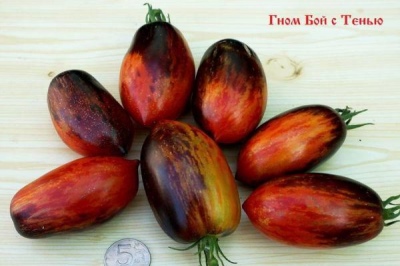
- Authors: Tom Wagner, USA (Tomato Gnome Series)
- Name synonyms: Dwarf Shadow Boxing
- Category: grade
- Growth type: determinant
- Appointment: universal
- Ripening period: mid-early
- Ripening time, days: 100-105 (greenhouse), 110-115 (open field)
- Growing conditions: for open ground, for film greenhouses
- Bush size: undersized
- Bush height, cm: up to 100
The standard variety Dwarf Shadow Fight is determinant, that is, it will not grow more than the length specified in the description. This is a great option for a film greenhouse or even for open ground, which is unpretentious and pleases with the quality of the fruit.
Description of the variety
The fruits can not only be eaten fresh and treated to guests, but also used for juices, tomato paste, and you can make twists for the winter in the form of whole tomatoes.
The bushes of the Gnome Shadow Fight are low, grow to a maximum of a meter in height. Stepping is required, however, as is the garter, as well as shaping. Usually, one bush of the described variety has from 2 to 3 stems.
The main qualities of the fruit
Ripe fruits have an interesting color. At the top, they are of a bright golden-orange hue, there are specks. From the stalk and throughout the peel, an anthocyanin of an almost black hue passes, which gently turns gradually into maroon. From the middle, you can see crimson and brown stripes.
Tomatoes of this variety are medium in size, with a maximum of 100 grams. The shape of the Dwarf Shadow Fight tomatoes is elongated, one might even say pepper-shaped. Up to 4 tomatoes are formed in one brush.
After harvest, the fruits can lie in the refrigerator or in the warehouse for a long time, if the necessary storage conditions are provided.
Taste characteristics
The tomatoes of this variety taste sweet, there is a slightly discernible fruity note. Under the skin is a fleshy, delicate pulp that has an incomparable aroma.
Ripening and fruiting
Gnome Shadowboxing is a mid-early variety, it ripens in a greenhouse in 100-105 days, in the open field a little longer - 110-115 days.
Yield
This variety is high-yielding.
The timing of planting seedlings and planting in the ground
The seeds are planted in pots from March 20 to April 10, in the ground from May 15 to June 5.

Growing tomato seedlings is an extremely important process, because it largely depends on whether the gardener can harvest at all. All aspects must be taken into account, from seedbed preparation to planting in the ground.
Landing scheme
The seedling planting scheme is simple: 50 cm between the beds and 40 cm between the bushes.

Growing and care
It is no big deal to feed Dwarf tomatoes Shadow Boxing. Just use a nitrogen-rich liquid fertilizer for the first weeks (read the label on the product to determine the optimal feeding schedule). After the tomato begins to bloom, they switch to high-potassium and phosphorus supplements. These are the main elements that influence the flavor, color and size of tomatoes. Without them, the harvest will be of poor quality.
It must be remembered that sick, lethargic Dwarf Shadow Fight tomatoes should not be fed with fertilizers. Such seedlings are starved until they begin to recover. Liquid fertilization leads to the accumulation of salts in the compost. It will be necessary to skip several feedings during the plant's life cycle, instead, it is better to give extra water to wash out these salts.
Particular attention to watering, since its quality largely affects the appearance of the fruit. Greenhouse tomato plants Shadow Fight need more watering than those grown outdoors. This strain will appreciate daily light watering much more than wet soil once a week. It is better to use drip irrigation as it has many advantages. So water does not get on the foliage, and fertilizers can also be supplied along with moisture. If watering is carried out at long intervals, and the earth is allowed to dry out, then waterlogged, this will lead to cracking or splitting of the skin of the tomatoes Dwarf Shadow Fight.
The best way to know if a tomato needs water is to examine the soil and foliage. The soil from above to a depth of 5 cm should be moist, but not damp, and the leaves should not wither. Dry soil and wilted, dark green leaves are a clear sign that the Shadowfight Dwarf is not getting enough water. On the other hand, damp soil and light (almost yellow) leaves are signs that you need to urgently reduce watering.




A plant needs different micronutrients at each stage of growth. All fertilizers can be divided into two groups: mineral and organic. Folk remedies are often used: iodine, yeast, bird droppings, eggshells.
It is important to observe the rate and period of feeding. This also applies to folk remedies and organic fertilizers.
Disease and pest resistance
For pests, use insecticides or organic remedies like neem oil or garlic infusion. Most diseases are treated with fungicides, which should be based on sulfur.



























































































